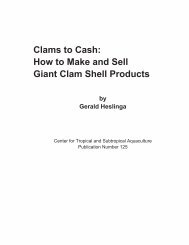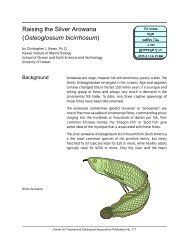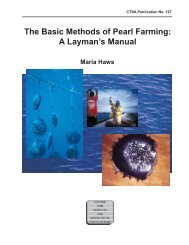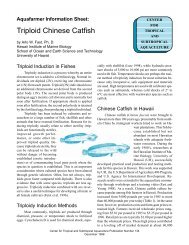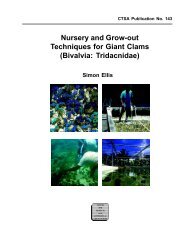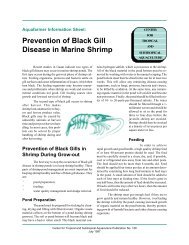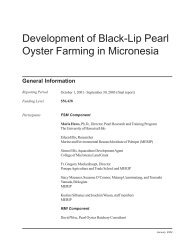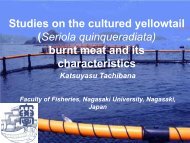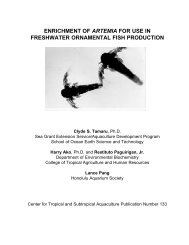Producing Pearls Using the Black-lip Pearl Oyster - CTSA
Producing Pearls Using the Black-lip Pearl Oyster - CTSA
Producing Pearls Using the Black-lip Pearl Oyster - CTSA
Create successful ePaper yourself
Turn your PDF publications into a flip-book with our unique Google optimized e-Paper software.
<strong>Producing</strong> <strong><strong>Pearl</strong>s</strong> <strong>Using</strong> <strong>the</strong> <strong>Black</strong>-<strong>lip</strong> <strong>Pearl</strong> <strong>Oyster</strong> (Pinctada margaritifera)Page 3in spat settlement. If farmers are aware of <strong>the</strong> time of <strong>the</strong>sepeaks <strong>the</strong>n <strong>the</strong>y can set <strong>the</strong>ir collectors to coincide with maximumspat fall.Hatchery rearing of <strong>Black</strong>-<strong>lip</strong> pearl oysters is a well understoodbut less commonly used method for obtaining animals.At <strong>the</strong> end of 1999 <strong>the</strong>re was only one <strong>Black</strong>-<strong>lip</strong> hatcheryin <strong>the</strong> U.S. Affiliated Pacific Islands in Majuro, RMI.Therefore it is likely that a farmer will need to obtain <strong>the</strong>iroysters using wild or spat collection methods.Farm construction and layoutA pearl farm is simply a structure that allows <strong>the</strong> oystersto be suspended in <strong>the</strong> water column at a depth of 3-7 m.This depth protects <strong>the</strong> oysters from rough wea<strong>the</strong>r whilestill making <strong>the</strong>m accessible to farm workers. Three methodsare primarily used for constructing pearl farms: longlines,rafts and underwater trestles. Farmers should choose <strong>the</strong>method that is cheapest and most convenient for <strong>the</strong> site that<strong>the</strong>y have chosen.Most <strong>Black</strong>-<strong>lip</strong> pearl oysters are farmed on longlines,which are lengths of strong rope anchored to <strong>the</strong> bottom andsuspended with floats at <strong>the</strong> desired depth. The floats alsoprovide tension in <strong>the</strong> line and keep it taught. Longlines arecheap and easy to install and are well-suited to <strong>the</strong> lagoontype farming conditions that prevail throughout <strong>the</strong> U.S. AffiliatedPacific Islands.Rafts (Figure 3) are generally used in well-protectedareas because <strong>the</strong>y float on <strong>the</strong> surface. They are usually constructedfrom barrels or o<strong>the</strong>r large floats and bamboo orwood lashed toge<strong>the</strong>r. Rafts would only be suitable for wellprotectedbays in <strong>the</strong> U.S. Affiliated Pacific Islands.Trestles (Figure 4) have a similar trellis structure to raftsexcept <strong>the</strong>y are attached by legs to <strong>the</strong> ocean floor. Whilesturdy and long-lasting, this system has <strong>the</strong> disadvantage ofbeing more costly than longlines and, like rafts, keeps <strong>the</strong>oysters in high densities <strong>the</strong>reby increasing <strong>the</strong> chances ofdisease outbreak. Trestles are suitable only for shallow bayareas and have been used in French Polynesia for holdingoysters after seeding and as spat nurseries.The choice of how to suspend <strong>the</strong> oysters from <strong>the</strong> farmstructure is also important. Juvenile oysters are usually keptin lantern nets, box nets (Figure 5) or mesh bags until <strong>the</strong>yare around 10 cm in length. At this point <strong>the</strong>y can be transferredinto pocket panels (Figure 5) or onto chaplets (Figure6). A pocket panel is a wire frame with a series of meshpockets into which individual oysters are placed. Chapletsare lengths of rope onto which oysters are hung by a piece ofwire that has been threaded through a hole drilled in <strong>the</strong>shell hinge. Chaplets are cheaper than pocket panels in generalbut oysters are sometimes lost from chaplets because <strong>the</strong>wire holding <strong>the</strong>m to <strong>the</strong> line snaps.Grafting or seedingThe grafting process is one of <strong>the</strong> most expensive andcritical aspects of pearl farming. Grafting (also called seeding)is <strong>the</strong> process whereby a bead or nucleus is implantedinto <strong>the</strong> oyster to form <strong>the</strong> pearl. This is a surgical procedurecarried out by a highly skilled technician who must be paidby <strong>the</strong> farmer. The technician first selects a donor oyster andremoves <strong>the</strong> mantle, which produces <strong>the</strong> nacre for <strong>the</strong> pearl.The mantle is trimmed and cut into small (2 mm) squares.One piece of <strong>the</strong> mantle is inserted into <strong>the</strong> gonad of <strong>the</strong>Figure 3. Raft pearl farm structure (from Gervis and Sims, 1992).Center for Tropical and Subtropical Aquaculture Publication Number 141December 1999



